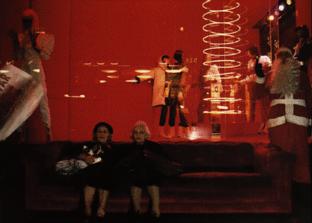
Bloomingdale Twins, New York City
"The first three pictures were self-consciously humorous, later photographs need not be. The photographers agreed that the couch in a series of portraits would serve as a constant element of design--something to build around like the swimming pool. It would also be a common denominator, a binding ingredient to create 'optical tension': most of all, it would be a neutral object that could change the meaning of a photograph by its inclusion alone. After all, contemporary art was then full of such juxtapositions, things pulled our of intended contexts and set in new locations.
"Clarke and Wackerbarth did not foresee that the deliberate misplacement of the couch would also help them interpret their own responses to a scene or measure a sitter's response to them; nor did they imagine just how such a foreign element--especially in the midst of the commonplace--could surprise a viewer of the finished photograph. They were aware, however, that the whole idea might appear as only a media gimmick."